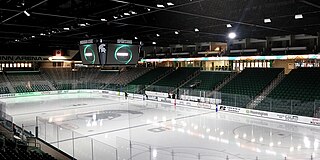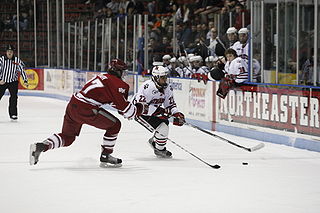
3M Arena at Mariucci is the home arena for the Minnesota Golden Gophers men's ice hockey team of the University of Minnesota. The arena is located on the Minneapolis campus and seats approximately 10,000 fans. The arena opened in 1993 and is named after John Mariucci, the longtime Gopher coach who is considered the "godfather of Minnesota hockey." Under the gate is a quote from Mariucci: "Through these gates walk the greatest fans in college hockey." The ice sheet was Olympic sized from 1993 to 2023, when construction began on reducing the rink floor size. The women's ice hockey team played at Mariucci from 1997 until 2002 when they moved to Ridder Arena, which is connected to Mariucci via a tunnel.

Michigan Stadium, nicknamed "The Big House," is the football stadium for the University of Michigan in Ann Arbor, Michigan. It is the largest stadium in the United States and the Western Hemisphere, the third-largest stadium in the world, and the 34th-largest sports venue in the world. Its official capacity is 107,601, but it has hosted crowds in excess of 115,000.

Crisler Center is an indoor arena located in Ann Arbor, Michigan. It is the home arena for the University of Michigan's men's and women's basketball teams as well as its women's gymnastics team. Constructed in 1967, the arena seats 12,707 spectators. It is named for Herbert O. "Fritz" Crisler, head football coach at Michigan from 1938 to 1947 and athletic director thereafter until his retirement in 1968. Crisler Center was designed by Dan Dworsky, a member of the 1948 Rose Bowl-winning Michigan football team. Among other structures that he has designed is the Federal Reserve Bank of San Francisco, Los Angeles Branch.

Herbert Orin "Fritz" Crisler was an American college football coach who is best known as "the father of two-platoon football", an innovation in which separate units of players were used for offense and defense. Crisler developed two-platoon football while serving as head coach at the University of Michigan from 1938 to 1947. He also coached at the University of Minnesota (1930–1931) and Princeton University (1932–1937). Before coaching, he played football at the University of Chicago under Amos Alonzo Stagg, who nicknamed him Fritz after violinist Fritz Kreisler.

Duluth Entertainment Convention Center (DECC) is a multi-purpose arena and convention center complex located in Duluth, Minnesota. It has been home to the University of Minnesota Duluth Bulldog men's hockey team since 1966. The DECC is located on the waterfront near Duluth's famous Aerial Lift Bridge.

Clarence L. Munn Ice Arena is a 6,114-seat hockey-only arena in East Lansing, Michigan on the campus of Michigan State University, situated across Chestnut Road from the Intramural Recreative Sports Center West and Spartan Stadium. It is home to the MSU's ice hockey team. Completed in 1974, the arena is named in honor of former MSU football coach and athletic director Clarence "Biggie" Munn.

Harry W. Lawson Ice Arena and Gabel Natatorium is a 3,667-seat multi-purpose arena, and adjacent natatorium in Kalamazoo, Michigan, located on the far Southwest corner of Western Michigan University's main campus. The arena is a single-level, horseshoe-style arena with a concourse at the top. It is home to the Western Michigan Broncos men's ice hockey team, the WMU men's ice hockey club team, and the WMU synchronized skating club team. The arena is named after Harry W. Lawson, the founder of the hockey program at Western Michigan University. The Gabel Natatorium contains an olympic size swimming pool, diving facility, and is home to the WMU Swimming and Diving Club team.

Appleton Arena is a 3,200-seat multi-purpose arena in Canton, New York. It is home to the St. Lawrence University Skating Saints ice hockey team. It was named for Judge Charles W. Appleton, class of 1897, the main benefactor of the arena as well as the riding center, which is named for his wife Elsa.

The Frank L. Messa Rink at Achilles Center is a 2,225-seat multi-purpose arena in Schenectady, New York. It is home to the Union College men's ice hockey and women's ice hockey teams, members of the ECAC Hockey League. The facility opened in 1975 as Achilles Rink and was named in honor of its original benefactor, the Rev. H. Laurence Achilles, Sr. In 2003, it was renovated and renamed Frank L. Messa Rink at Achilles Center in honor of Frank L. Messa, class of 1973, whose generosity made the renovation possible. One of the unique and distinguishing features of the building is its light colored wooden dome roof which is supported by a complex geometric pattern of dark colored wooden beams. The arena also houses the Travis J. Clark '00 Strength Training Facility.

The Frank Ritter Memorial Ice Arena, known colloquially as "The Ritter", is an arena on the campus of the Rochester Institute of Technology in Henrietta, a suburb of Rochester, New York, United States. It is the former home to the RIT Tigers ice hockey teams and the Genesee Figure Skating Club. Its official capacity for ice hockey games was 2,100.

The Robert and Concetta Dwyer Arena houses two ice surfaces, a starbucks, and a pro shop on Niagara University's campus in Lewiston, New York, United States. The main rink can seat up to 1,400 people and is the home to the Niagara Purple Eagles men's ice hockey team, which plays in Atlantic Hockey. The arena was formerly home to the women's ice hockey team, which played in College Hockey America.

College ice hockey is played principally in the United States and Canada, though leagues exist outside North America.

Wentzville Ice Arena is an arena and recreational sport facility located in Wentzville, Missouri and owned and operated by the City of Wentzville Parks & Recreation Department. It served as the home for LU Lindenwood Lions Men's and Women's ice hockey teams and LU synchronized skating team until relocating to the newly built Centene Community Ice Center.

The Michigan Wolverines men's ice hockey team is the college ice hockey team that represents the University of Michigan in Ann Arbor, Michigan. Earning varsity status in 1922, the program has competed in 102 seasons. Between 1959 and 1981, the team competed in the Western Collegiate Hockey Association (WCHA) before joining the Central Collegiate Hockey Association (CCHA) until the 2012–13 season. Since the 2013–14 season, the Wolverines have competed in the Big Ten, which began sponsoring hockey.

The Amelia Park facilities are located in Westfield, Massachusetts, United States. The Amelia Park Ice Rink is the only ice rink in Westfield. The main building is a 47,000-square-foot (4,400 m2) facility, a figure skating lounge, three party rooms, a skate rental and sharpening area, four locker rooms and a food concession area. A 65' x 170' outside inline skating rink is located next to the main building. The $6 million facility was created by Albert Ferst in memory of his late wife, Amelia. The facility houses activities and events, such as open skating times, hockey games for Westfield State University, St. Mary's High School, Westfield High School, and Sled Hockey Games. Gardens span 3.1 acres (13,000 m2) and are located across from the main entrance of the arena.
The LaHaye Ice Center is a 4,000-seat ice arena located in Lynchburg, Virginia on the campus of Liberty University. The ice arena is also the home to the Liberty Flames men's and women's ice hockey teams that currently compete in the American Collegiate Hockey Association as independent teams in the ACHA Division I. In addition to LU's varsity teams, the Liberty JV team, Virginia Military Institute, and Lynchburg College teams at the ACHA Division II level playing in the Blue Ridge Hockey Conference also use the arena. And for LU's synchronized skating team. The ice arena is also used for various recreational uses by students and local public for ice skating, figure skating, ice hockey, and broomball.

The Compton Family Ice Arena is a 5,022-seat, two-rink ice facility in Notre Dame, Indiana on the campus of the University of Notre Dame. The arena saw its first game on October 21, 2011. The ice arena replaced the 2,857-seat rink in the north dome of the Edmund P. Joyce Center.

The 1991–92 Michigan Wolverines men's ice hockey team represented the University of Michigan in intercollegiate college ice hockey during the 1991–92 NCAA Division I men's ice hockey season. The head coach was Red Berenson and the team captain was David Harlock. The team played its home games in the Yost Ice Arena on the University campus in Ann Arbor, Michigan. The team finished first in the Central Collegiate Hockey Association regular season and qualified for the Frozen Four of the 1992 NCAA Division I Men's Ice Hockey Tournament. In the tournament, Michigan was a number one seed in the West Region and defeated Northern Michigan 7–6 in the quarterfinals before losing to Wisconsin 4–2 in the semifinals, but Wisconsin's participation has been vacated.

The Herb Brooks National Hockey Center, also known as the Brooks Center, is a 5,159-seat hockey arena in St. Cloud, Minnesota. It is home to the St. Cloud State University Huskies men's & women's ice hockey teams, and the Saint John's University Johnnies ice hockey team. The main rink is named for the late university President Brendan J. McDonald, who advocated the team's move to Division I hockey. The arena consists of a lower and upper deck on the sides the ice. The west end features a few seats, while east contains no seating.

Phyllis Ocker Field is a 1,500 seat field hockey field on the main campus of the University of Michigan in Ann Arbor, Michigan. The field is named after Phyllis Ocker, a former University of Michigan teacher, field hockey coach, and athletics administrator. The facility opened in 1995.





















